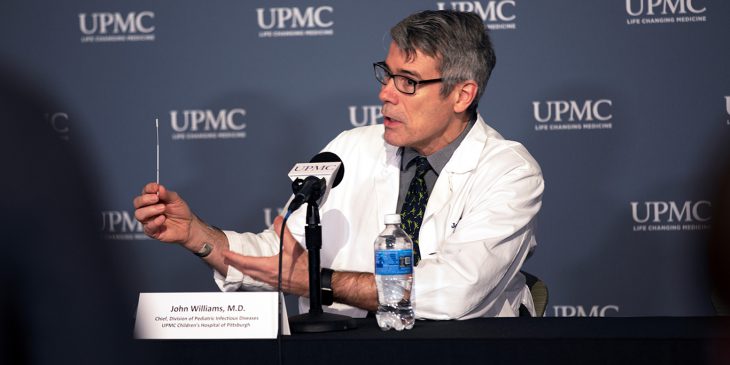Dr. John Williams, chief of the Division of Pediatric Infectious Diseases at UPMC Children’s Hospital of Pittsburgh, announced at a press conference today that a team of UPMC researchers is working to test for and monitor the spread of COVID-19 in the Pittsburgh community. This testing approach will complement the new COVID-19 test developed by UPMC, also announced today, to help detect community transmission.
Since February, Williams’ team has taken more than 300 samples from adult and pediatric populations who were feeling sick enough with cold and flu-like symptoms to visit their doctors. These samples are tested for SARS-CoV-2, the virus that causes COVID-19, with a research-only version of the COVID-19 test used by the Centers for Disease Control and Prevention.
 “This allows us to take a pulse on when the virus arrives in our region,” Williams said. “Even though the test cannot diagnose an individual with COVID-19, it can alert public health authorities early when the virus is beginning to spread so certain interventions that our community has already started – such as school and event cancellation – can be ramped up or extended for longer periods.”
“This allows us to take a pulse on when the virus arrives in our region,” Williams said. “Even though the test cannot diagnose an individual with COVID-19, it can alert public health authorities early when the virus is beginning to spread so certain interventions that our community has already started – such as school and event cancellation – can be ramped up or extended for longer periods.”
So far, none of the samples have tested positive for COVID-19.
Williams reiterated that if a test did come back positive for COVID-19, there would be no way to identify the patient from the positive sample. The data from the testing is being shared with public health authorities, providing a form of community surveillance extremely valuable to the Pittsburgh region. This approach gives UPMC and public health officials insight into how widespread COVID-19 is in our community, and how well our infection prevention strategies are working.
Even though the initial test results are reassuring, Williams stressed that we need to remain vigilant: “This doesn’t mean we should let down our guard. This is still a critical public health threat.”
Individuals should continue to practice social distancing, covering your cough and sneeze, and hand hygiene to help stop the spread of COVID-19 in our communities.
“Finding no virus in these samples means that our prevention strategy has a chance of working to slow the spread in our region,” Williams explained. “The goal is prevention before it arrives, not mitigations after it’s already here. These social distancing tactics work best before the virus is widespread in our community. If we stop, then what we are doing now was for naught. I strongly encourage you all to comply with the local, state and federal mandates.”
UPMC will be regularly updating the community on this developing situation. Follow UPMC News for updates.









